AUDI A8 2018 Owners Manual
Manufacturer: AUDI, Model Year: 2018, Model line: A8, Model: AUDI A8 2018Pages: 356, PDF Size: 54.71 MB
Page 211 of 356
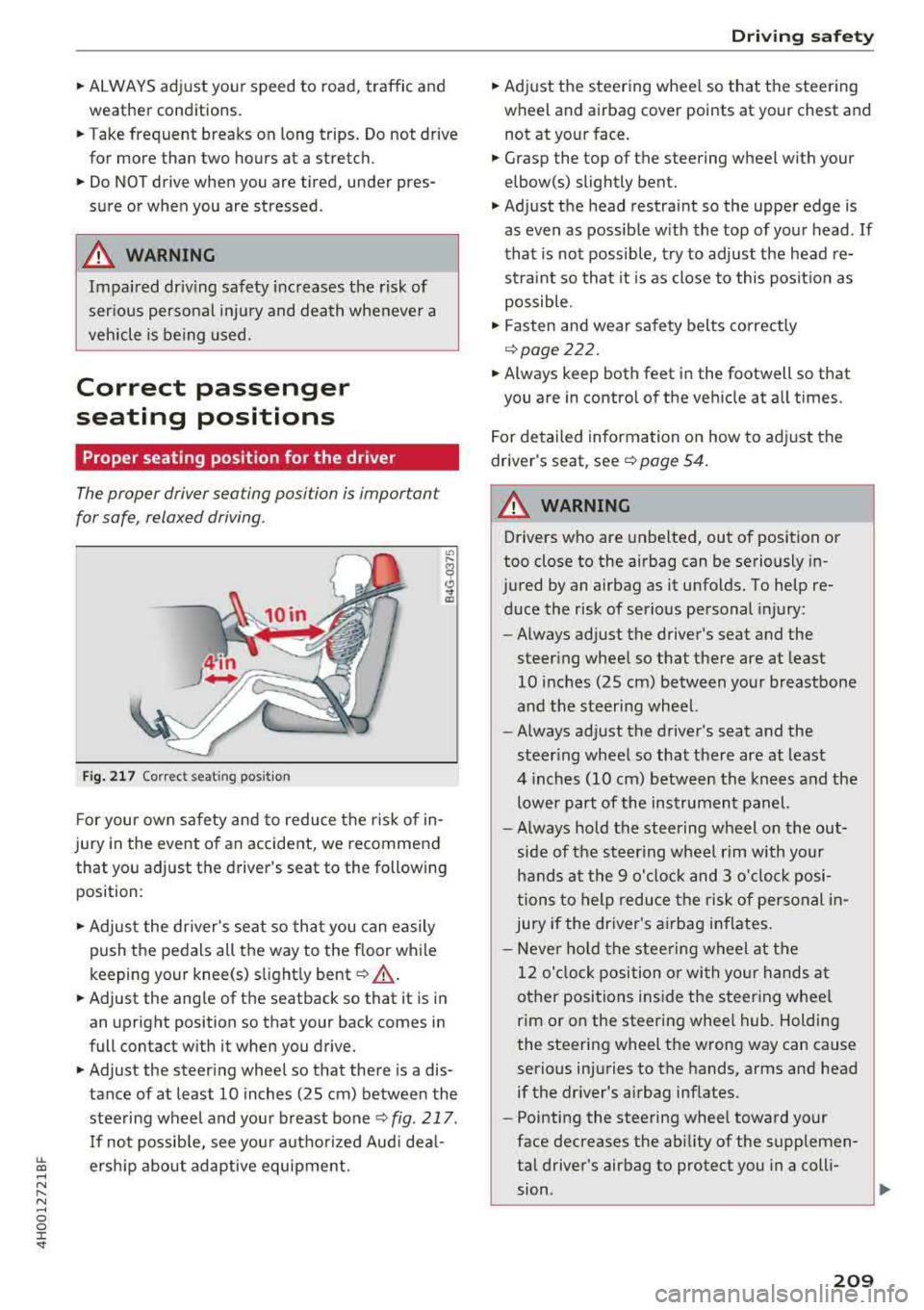
lL t:0 ....
"' ......
"' .... 0 0 :c '
weather conditions.
~ Take frequent breaks on long trips. Do not drive
for more than two hours at a stretch.
~ Do NOT drive when you are tired, under pres
s ure or when you are stressed .
A WARNING
Impaired driv ing safety increases the risk of
ser ious personal inj ury and death whenever a
vehicle is being used .
Correct passenger
seating positions
Proper seating position for the driver
The proper driver sea ting po sit ion is impor tan t
for safe, relaxed driving .
Fig. 217 Correc t seat ing posit ion
F or your own s afety and to reduce the risk of in
jury in the event of an accident, we recommend
that you adjust the driver 's seat to the following
position :
~ Adjust the dr iver's seat so tha t you can easily
push the pedals all the way to the f loor wh ile
keeping your knee(s) s light ly bent
c:!;> _& .
~ Adjust the ang le of the seatback so that it is in
an upright position so that your back comes in
full contact w ith it when you drive.
~ Adjust the steering wheel so that there is a dis
tance of at least 10 inches (25 cm) between the
stee ring wheel and you r breast bone
<:!;> fig . 217 .
If no t possib le, see you r autho riz ed Aud i dea l
ersh ip about adaptive equipment .
Driving safety
~ Adjust the steering wheel so that the steering
wheel and airbag
cover points at your chest and
not at yo ur face.
~ Grasp the top of the steering wheel with you r
elbow(s) slightly bent.
~ Adjust the head restraint so the upper edge is
as
even as possible w ith the top of your head . If
that is not possible, t ry to adjust the head re
s traint so that it is as close to this posit ion as
possible .
~ Fasten and wear safety belts correctly
c:!;> page 2 2 2.
~ Always keep both feet in the footwell so that
you are in contro l of the ve hicle at a ll times .
F or detailed information on how to adj ust the
driver's seat,
see r:!;> page 54 .
A WARNING
-
Drivers who are unbelted, out of position or
too close to the airbag can be se riously in
jured by an airbag as it unfolds. To help re duce the risk of serious personal injury:
- Always ad just the driver's seat and the
steer ing whee l so that there are at least
10 inc hes (25 cm) between you r breastbone
and the steer ing wheel.
- Always ad just the d river's seat and the
steer ing wheel so that there are at least
4 inches (10 cm) between the knees and the
lowe r part of the instrument panel.
- Always hold the steering w heel on the out
side of the steering wheel r im with yo ur
hands at the 9 o'clock and 3 o'clock posi
tions to help reduce the risk of personal in
jury if the driver's airbag inflates.
- N ever hold the stee ring wheel at the
12 o' clock position o r wi th yo ur hands at
other posi tions i nside the steer ing whee l
rim or on the steering wheel hub . Holding
the steering wheel the wrong way can cause
serio us injuries to the hands, arms and head
if the dr iver's airbag inf lates .
- Pointing the steering wheel toward your
face decreases the abi lity of the supplemen
tal driver's airbag to protect you in a coll i-
sion .
..,
209
Page 212 of 356
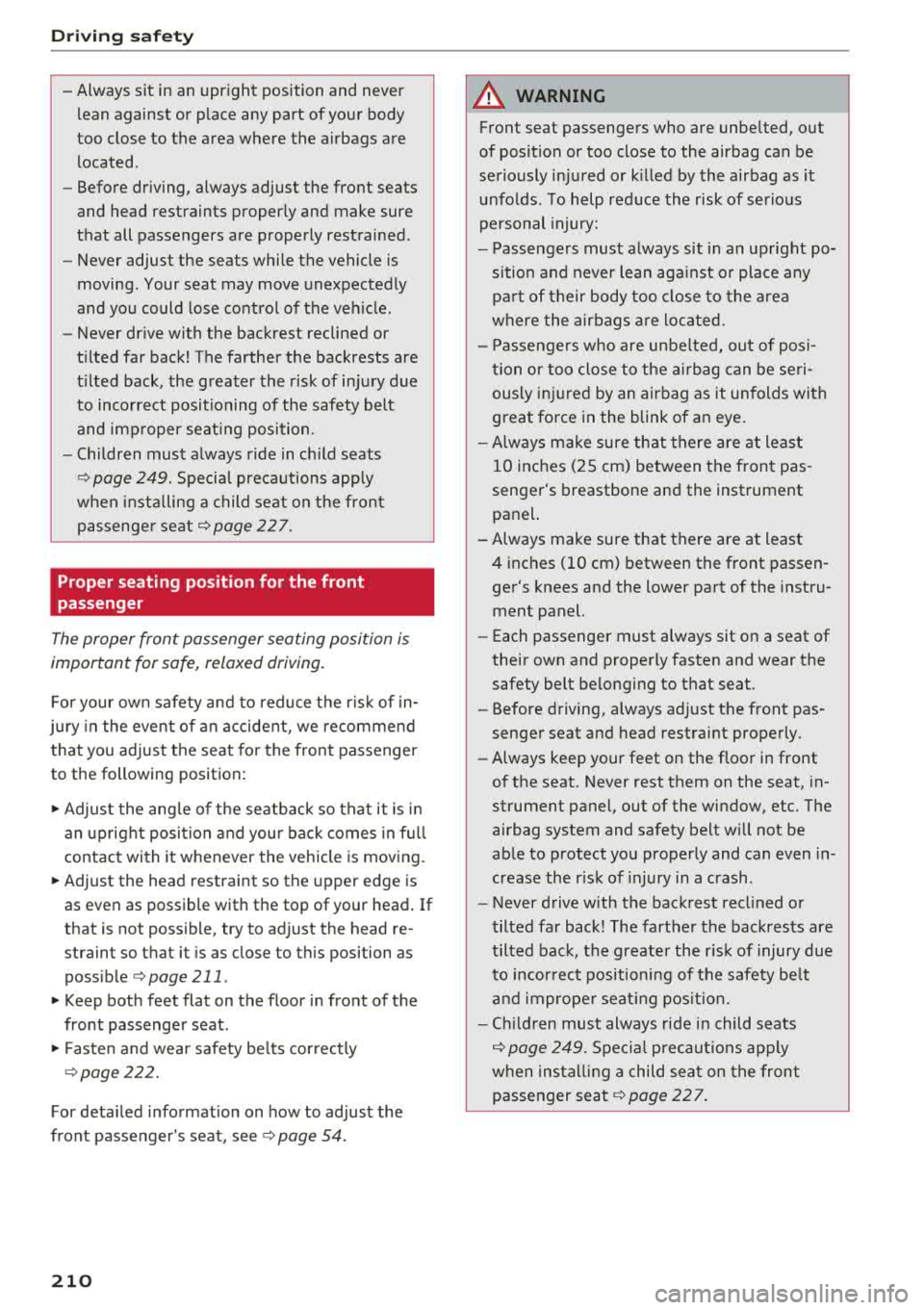
Drivin g saf ety
- Always sit in an upright position and never
lean against or p lace any part of your body
too close to the area where the airbags are located.
- Before dr iving, always adjust the front seats
and head restraints properly and make sure
that all passengers are properly restrained .
- Never adjust the seats while the vehicle is
moving . Your seat may move unexpectedly
and you could lose control of the vehicle.
- Never dr ive with the backrest reclined or
t ilted far back! The farther the backrests are
t ilted back, the greater the risk of injury due
to incorrect positioning of the safety belt and imp roper seating position.
- Children must always ride in child seats
¢ page 249. Special precautions apply
when installing a child seat on the front
passenge r
seat¢ page 22 7.
Proper seating position for the front
passenger
The proper front passenger seating position is
important for safe, relaxed driving.
F or your own safety and to reduce t he risk of in
ju ry in the event of an accide nt, we recomme nd
that you adjust the seat for the front passenger
to the following position:
.,. Adjust the ang le of t he seatback so that it is i n
an upright posit ion and you r back comes in f ull
contact wi th it w henever the vehicle is mov ing.
.,. Adjust the head restraint so the upper edge is
as even as possible with the top of your head . If
that is not possible, try to ad just the head re
straint so that it is as close to this position as
poss ible
¢ page 211.
.,. Keep both feet flat on the floor in front of the
front passenger seat .
.,. Fasten and wear safety be lts cor rect ly
¢ page 222.
For deta iled i nformation on how to adjust the
front passenger's seat, see
¢ page 54.
210
A WARNING
Front seat passengers who are unbelted, out
of position or too close to the airbag can be
seriously injured or k illed by the airbag as it
unfo lds. To help red uce the risk of serio us
personal injury:
- Passengers must a lways sit in an upright po
sition and never lean aga inst or place any
p art of their body too close to the are a
where the air bags a re loc ated.
- Passengers who are unbelted, out of posi
tion or too close to the airb ag can be se ri
ously in jured by an airbag as it unfolds wi th
great fo rce in the blink of an eye .
- Always make sure th at there are at least
10 inches (2 5 cm) between the fron t pas
senger's breastbone an d the instrument
panel.
- Always make sure that there are at least 4 inches (10 cm) between the front passen
ge r's knees and the lower pa rt of the inst ru
ment panel.
- Each passenger must always sit on a seat of
their own and properly fasten and wear the
safety belt belonging to that seat .
- Before d riving, always ad just the front pas
senger seat and head restraint properly.
- Always keep your feet on the floor in front
of the seat. Never rest them on the seat, in
strument panel, out of the window, etc . The
airbag system and safety belt w ill not be
ab le to protect you properly and can even in
crease the r isk of injury in a crash .
- Never drive with the backrest recl ined or
tilted far back! The farther the backrests are
tilted bac k, the greater the r is k of injury due
to incor rec t positioning of the safety be lt
a nd imprope r seat ing pos ition .
- Ch ild ren must always ride in child seats
¢ page 249 . Special pre caut ions apply
when install ing a child sea t on the front
passenger
sea t¢ page 22 7 .
Page 213 of 356
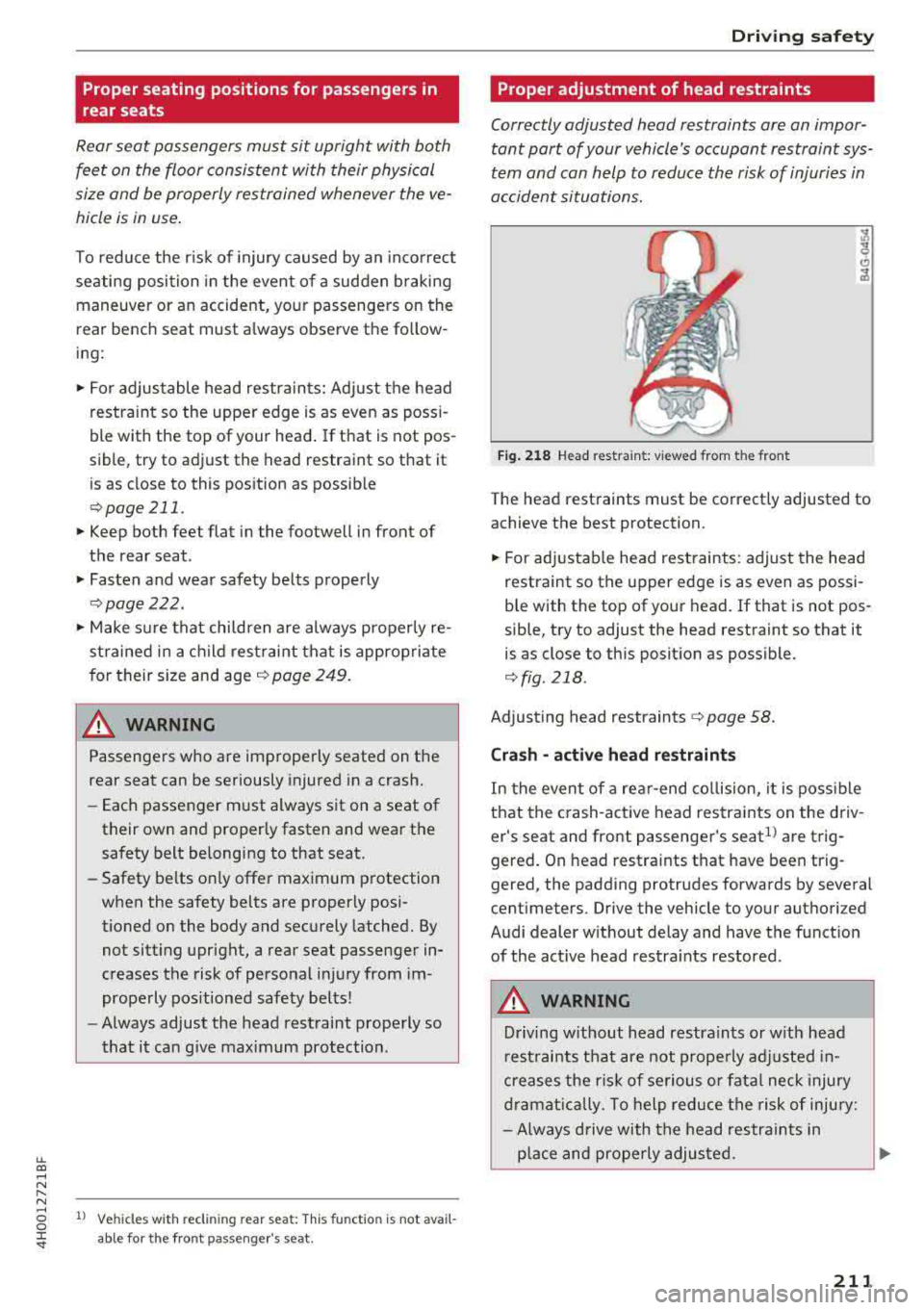
lL t:0 ....
'"" ......
'"" .... 0 0 :c '
rear seats
Rear seat passengers must sit upright with both
fee t on the fl oor consistent with their physical
size and be properly restrained whenever the ve
hicle is in use .
To reduce the r isk of injury caused by an incorrect
seating position in the event of a sudden b raking
maneuver or a n accident, your passengers on the
rear bench seat must a lways observe the follow
ing:
• For adjustable head restraints: Adjust the head
restraint so the upper edge is as even as poss i
ble with the top of your head . If that is not pos
sibl e, try to adjust the h ead restraint so that it
is as close to this position as possib le
c> page 211.
• Keep bo th feet flat in the footwell in front of
the rear seat .
• Fasten and wear safety belts properly
c>page222 .
• Make sure that child ren are always properly re
strained in a child restraint that is appropriate
for their size and age
c> page 249.
8_ WARNING
Passengers who are improperly seated on the
rear seat can be seriously injured in a crash.
- Each passenger m ust always sit on a seat of
their own and proper ly fasten and wear the
safety belt belonging to that seat.
- Safety belts only offer maximum p rotection
when the safety belts are properly posi
t ioned on the body and securely latched. By
not sitt ing upright, a rear seat passenger in
c reases the risk of personal injury from im
properly pos itioned safety belts!
- Always adjust the head restraint properly so
that it can g ive maximum protection .
1l Vehicl es with re clin in g re ar seat: This fun ction is not avail·
abl e fo r the front passe ng er 's s eat.
Dri ving safety
Proper adjustment of head restraints
Correctly adjusted head restraints are an impor
tant part of your vehicle's occupant restraint sys
tem and can help to reduce the risk of injuries in
accident situations.
F ig . 218 H ead restrain t: v ie wed from t he front
The head r est raints must be correct ly adjusted to
a chieve the best p rotection.
• For adj ustab le head restraints: adjust the head
restraint so the upper edge is as even as possi
bl e wi th th e top of your he ad . If that is not pos
s ible, try to adjust the head restraint so that it
is as close to this posit ion as possible.
¢ fig . 218 .
Adjusting head restraints c> page 58.
Crash - active head restraints
In the event of a re ar-end co llision, i t is poss ible
that the c rash -active head restra ints on the driv
er 's seat and front passenger's
seat1
) are trig
gered . On head restraints that have been trig
gered, the padding protrudes forwards by several
cent imeters. Drive the vehicle to your authori zed
Audi dealer w ithout delay and have the funct ion
of the act ive head restra ints restored .
8_ WARNING
-Driving without head restraints or w ith head
r est rai nts that are not prope rly a dju sted in
creases the ris k of serious or fata l neck injury
dramat ica lly . To help reduce the risk of injury:
- Always d rive with the head restra ints in
p lace and properly adjus ted .
211
Page 214 of 356

Drivin g saf ety
- Every person in the vehicle must have a
properly adjusted head restra int.
- Always make sure each person in the vehicle
properly adjusts their head restraint. Adjust
the head restra int so the upper edge is as
even as possib le w ith the top of your head.
If that is not possible, try to adjust the head
restra int so that it is as close to th is position
as possib le.
- Never attempt to adjust head restraint wh ile driving.
If you have dr iven off and
must adjust the driver headrest for any rea
son, fi rst s top the vehicle safely before at
tempting to ad just the head restra int.
- Children must always be p roperly restrained
in a chi ld restrain t that is appropria te fo r
their age and size
q page 249.
Examples of improper seating positions
The occupant restraint system con only reduce
the risk of injury if vehicle occupants ore properly
sea ted.
I mp roper seating posit ions can cause se rious in
ju ry or deat h. Safety belts can only wo rk when
t hey are p roper ly posit ioned o n the body . Im
p roper seating posi tions reduce t he effect iveness
of safety belts and wi ll even increase the risk of
inj ury and death by moving the safety be lt to crit
ical areas of the body. Improper seating posit ions
also increase the risk of ser ious injury and death
when an airbag deploys and str ikes an occupant
who is not in the proper seat ing position . A driver
is responsible for the safety of a ll vehicle occu
pants and especially fo r ch ildre n. Therefo re :
"' Never allow anyone to assume an incorrect
seat ing pos ition w hen the ve hicle is being used
q& .
The fo llow ing bulletins list only some sample po
sitions that wi ll increase the risk of ser ious injury
a nd death . Our hope is that these examples will
make you more aware of seat ing pos it ions that
are dangero us.
Therefore, whenever the vehicle is moving:
- never stand up in the ve hicle
- never stand on the seats
212 -
neve r kneel on the seats
- neve r ride w it h the sea tback re clined
- neve r lie down on the seats
- never lean up aga inst the instrument panel
- never s it on the edge of the seat
- never s it sideways
- never lean out the window
- never put your feet out the window
- neve r put your feet on the instr ument panel
- neve r rest you r feet on the seat c ushion or bac k
of t he se at
- neve r ride in the footwell
- never ride in the cargo area
A WARNING
Imp roper seating posi tions inc rease the risk
of ser ious personal inju ry and death whenever
a veh icle is being used.
- Always make sure that all veh icle occupants
s tay in a proper sea ting posit ion and a re
properly restrained whenever the vehicle is
be ing used .
Driver's and front
passenger's footwell
Important safety instructions
A WARNING
A lways make su re that the knee airbag can in
flate w ithout interference. Objects between
yourself and the airbag can inc rease the risk
of injury in an accident by interfering with the
way the airbag dep loys o r by being pushed in
to you as the airbag dep loys .
- No persons (ch ild ren) or animals should ride
in the footwell in front of the passenger
seat . If the airbag deploys, this can res ult in
serious or fatal injuries.
- No objects of any kind should be carried in
the footwell area in front of the dr iver's or
passenger's se at. Bu lky objects (shopping
bags, for examp le) can ham per or prevent
proper dep loymen t of the airbag . Sma ll ob
jects can be thrown thro ugh the vehicle if
the air bag deploys and in jure you or your
passengers.
Page 215 of 356
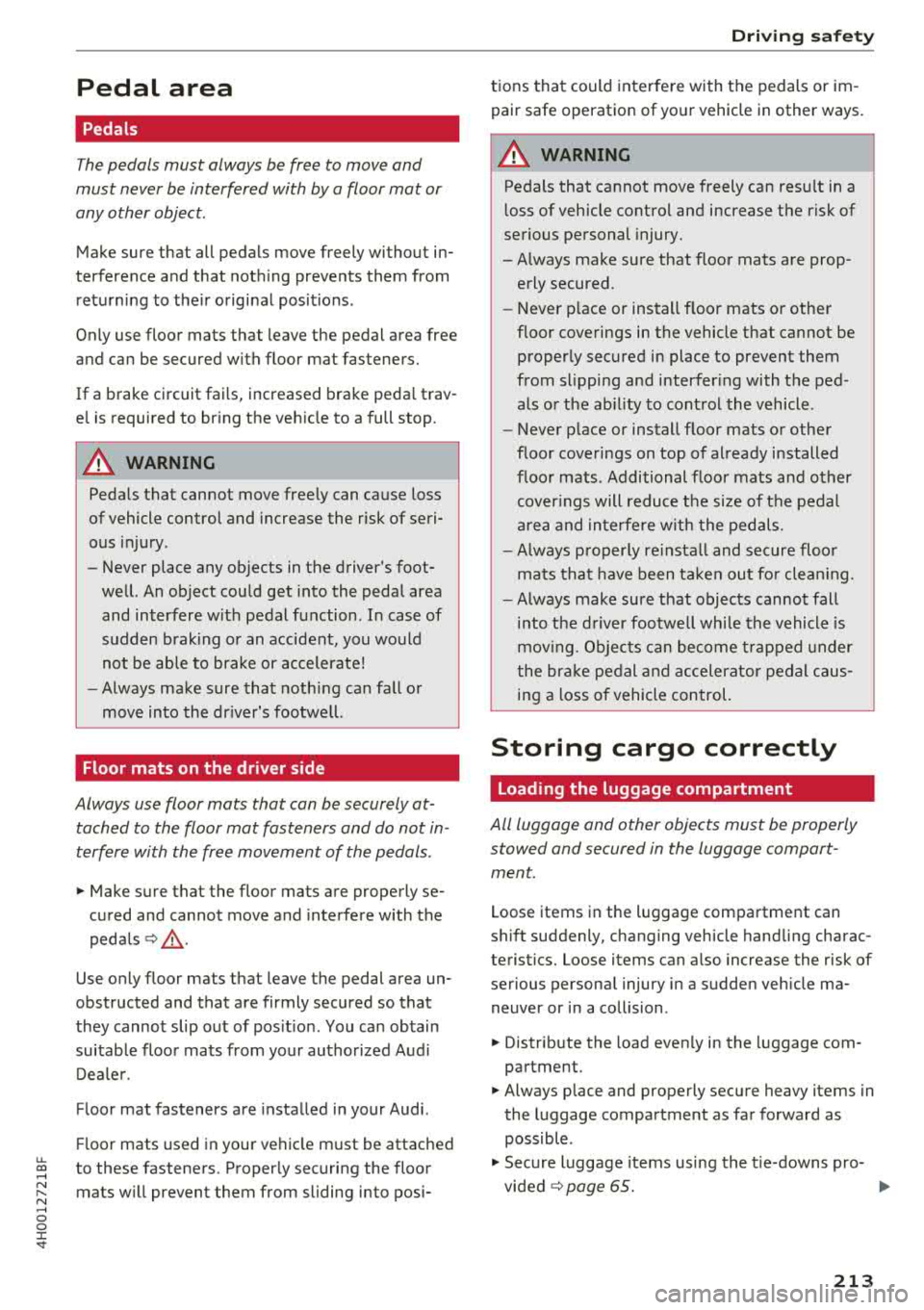
Pedal area
Pedals
The pedals must always be free to move and
must never be interfered with by a floor mat or
any other object.
Make sure that all pedals move freely without in
terference and that noth ing prevents them from
return ing to the ir original positions .
Only use floor mats that leave the pedal area free
and can be secured with floor mat fasteners.
If a brake circuit fails, increased brake peda l trav
e l is required to bring the vehicle to a full stop.
A WARNING
Peda ls that cannot move free ly can cause loss
of vehicle control and increase the risk of seri
ous injury .
- Never place any objects in the driver's foot
well. An object could get into the pedal area and interfere w ith pedal function . In case of
sudden braking o r an accident, you would
not be able to brake or accelerate!
- Always make sure that nothing can fall or
move into the dr iver's footwe ll.
Floor mats on the driver side
Always use floor mats that can be securely at
tached to the floor mat fasteners and do not in
terfere with the free movement of the pedals .
.. Make sure that the floor mats are properly se
cured and cannot move and interfere with the
pedals ~,&. .
Use only floor mats that leave the pedal area un
obstructed and that are firmly secured so that
they cannot slip out of pos it ion . You can obtain
suitab le floo r mats from your autho rized Aud i
Dea le r.
F loor mat fasteners are installed in your Audi.
Fl oor mats used in your vehicle must be attached
u. ~ to these fasteners. Properly securing the floor
~ mats w ill prevent them from sliding into posi-N ...... 0 0 :c '
tions that could interfe re with the pedals or im
pair safe operation of your vehicle in other ways.
A WARNING
--
Pedals that cannot move freely can res ult in a
l oss of vehicle contro l and increase the risk of
serious personal injury.
- Always make sure that floor mats are prop erly secured.
- Never p lace or install floor mats o r othe r
floor coverings in the vehicle that cannot be properly secured in place to prevent them
from slipping and interfer ing with the ped
als o r the ab ility to cont rol the vehicle .
- Never p lace or install floor mats or other
floor coverings on top of al ready installed
floor mats . Additional floor mats and other
cover ings will reduce the si ze of the pedal
a rea and in terfere with the pedals.
- Always p roperly re insta ll and secure floor
mats tha t have been ta ken ou t fo r clean ing.
- Always make sure that objects cannot fall
into the d river footwe ll whi le the vehicle is
mov ing.
Objects can become trapped under
the brake pe dal and accelerator pedal caus
ing a loss o f vehicle control.
Storing cargo correctly
Loading the luggage compartment
All luggage and other objects must be properly
stowed and secured in the luggage compart
ment.
Loose items in the luggage compartment can
shift suddenly, changing vehicle handling charac
teristics. Loose items can a lso increase the risk of
serious persona l injury i n a sudden veh icle ma
neuver or in a collision .
.. Distribute the load even ly in the luggage com
partment .
.. Always place and properly secure heavy items in
the luggage compartment as far forward as
possible .
.. Secure luggage items using the tie-downs pro-
vided
~ page 65. ..,
213
Page 216 of 356

Drivin g saf ety
A WARNING
Improperly stored luggage or other items can
fly through the vehicle causing serious per sonal injury in the event of hard braking or an
accident. To help reduce the risk of serious
personal injury:
- Always put objects, for example, luggage or other heavy items in the luggage compart
ment.
- Always secure objects in the luggage com
partment using the tie-down hooks and
suitable straps .
A WARNING
Heavy loads will influence the way your vehi
cle handles. To help reduce the r isk of a loss
of control leading to serious pe rsonal injury:
- Always keep in mind when transporting heavy objects, that a change in the center of
grav ity can also cause changes in vehicle
hand ling:
- Always distribute the load as even ly as
possible.
- Place heavy objects as far forward in the
luggage compartment as poss ible.
- Never exceed the Gross Axle Weight Rating
o r the Gross Vehicle Weight Rating specified
on the safety compliance sticker on the left
doo r jamb. Exceed ing permissible weight
standards can cause the vehicle to slide and
hand le differently .
- Please observe information on safe driving
c> page 208.
A WARNING
To help prevent poisonous exhaust gas from
being d rawn into the vehicle, always keep the
rear lid closed whi le driving.
- Never transport objec ts larger than those
fi tt ing complete ly into the luggage a rea be
ca use the rear l id cannot be fully closed.
- If you absolutely mus t drive w ith the rea r lid
open, obse rve the follow ing notes to reduce
t h e risk of poisoning:
- Close all windows,
- Close the power roof,
214
-
- Open all a ir outlets in the instrument pan
el,
- Switch off the air reci rculat ion
'
- Set the fresh air fan to the highest speed .
A WARNING -
Always make su re that the doo rs, all win
dows, the powe r roof and the rear lid are se
curely closed and locked to re duce the risk of
in jury when the veh icle is not being used.
- After closing the rear lid, always ma ke sure
that it is properly closed and locked.
- Never leave your veh icle unattended espe
cially with the rear lid left open . A child
could crawl into the vehicle through the lug
gage compartment and close the rea r lid be
coming trapped and unab le to get o ut. Be
ing trapped in a vehicle can lead to ser ious
pe rsonal injury.
- Never let ch ildren play in o r around the vehi
cle.
- Never let passengers ride in the luggage
compa rtment . Vehicle occupants mus t al
ways be properly restrained in one of the ve hicle's seat ing pos itions.
(D Tips
- Air circulation helps to reduce w indow fog
ging . Stale ai r esca pes to the outs ide
through vents in the trim panel, on the left
side of the luggage compartment. Be sure
to keep t hese s lo ts free and open.
- T he tire p ressure must correspond to the
load. The t ire pressure is shown on t he tire
press ure label. The ti re pre ssure label is lo
c ated on the drive r's side B- pilla r. The tire
pressu re label lists the recommen ded cold
t ire inflation pressures fo r the veh icle at its
maximum capac ity we ight and the tires that
we re on your veh icle at the time it was man
ufactured . For recommended t ire pressures
for normal load conditions, p lease see chap
ter
c> page 294.
Page 217 of 356
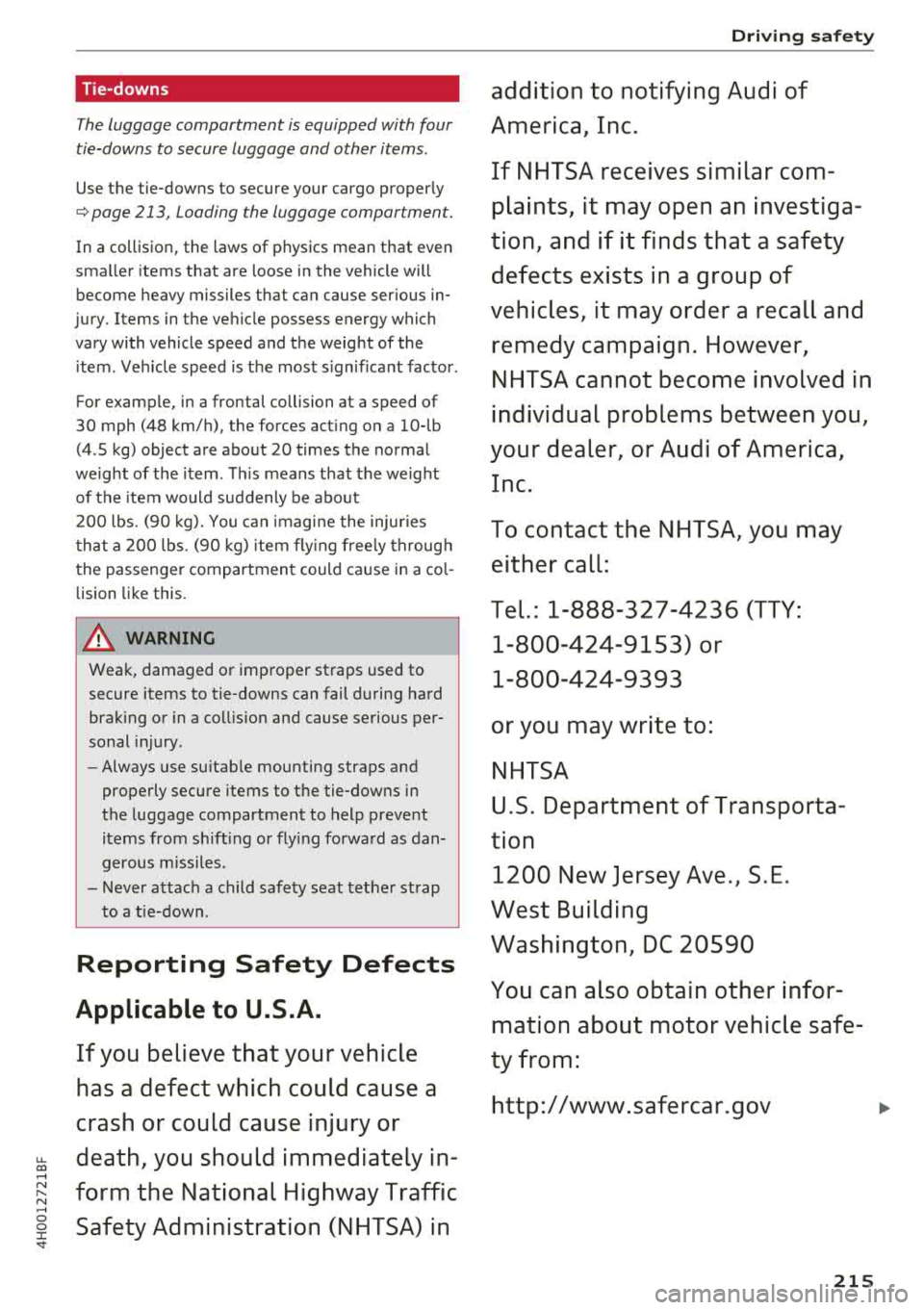
Tie-downs
The luggage compartment is equipped with four
tie-downs to secure luggage and other items .
Use the tie-downs to secure your cargo properly
¢ page 213, Loading the luggage compartment.
In a collision, the laws of physics mean that even
sma ller items that are loose in the vehicle will
become heavy missiles that can cause ser ious in
jury . Items in the ve hicle possess energy which
vary with vehicle speed and the weight of the item . Veh icle speed is the most s ignif ica nt factor .
For example, in a frontal collision at a speed of
30 mph (48 km/h), the forces act ing o n a 10-lb
(4 .5 kg) object are about 20 times the normal
weight of the item . This means that the weight
of the item would suddenly be about
200 lbs . (90 kg). You can imagine the injuries
t hat a 200 lbs. (9 0 kg) item flying freely throug h
the passenger compartment could cause in a col
lision like this.
A WARNING
Weak, damaged or improper straps used to
secure items to tie-downs can fail during hard
brak ing or in a col lision and cause serious per
sonal injury .
- Always use suitab le mounting straps and
properly secure items to the tie-downs in
the luggage compartment to help prevent
items from shifting or flying forward as dan
gerous missiles .
- Never attach a child safety seat tether strap
to a tie-down .
-
Reporting Safety Defects
Applicable to U.S.A.
If you believe that your vehicle
has a defect which could cause a
crash or could cause injury or
~ death, you should immediately in-
....
~ form the National Highway Traffic ....
~ Safety Administration (NHTSA) in
'
addition to notifying Audi of
America, Inc.
If NHTSA receives similar com
plaints, it may open an investiga
tion , and if it finds that a safety
defects exists in a group of
vehicles, it may order a recall and
remedy campaign. However,
NHTSA cannot become involved in
individual problems between you,
your dealer, or Audi of America,
Inc.
To contact the NHTSA, you may
either call:
Tel.: 1-888-327-4236 (TTY:
1-800-424-9153) or
1-800-424-9393
or you may write to:
NHTSA
U.S. Department of Transporta
tion 1200 New Jersey Ave ., S.E.
West Building
Washington , DC 20590
You can also obtain other infor
mation about motor vehicle safe
ty from:
http:/ /www.safercar.gov
215
Page 218 of 356
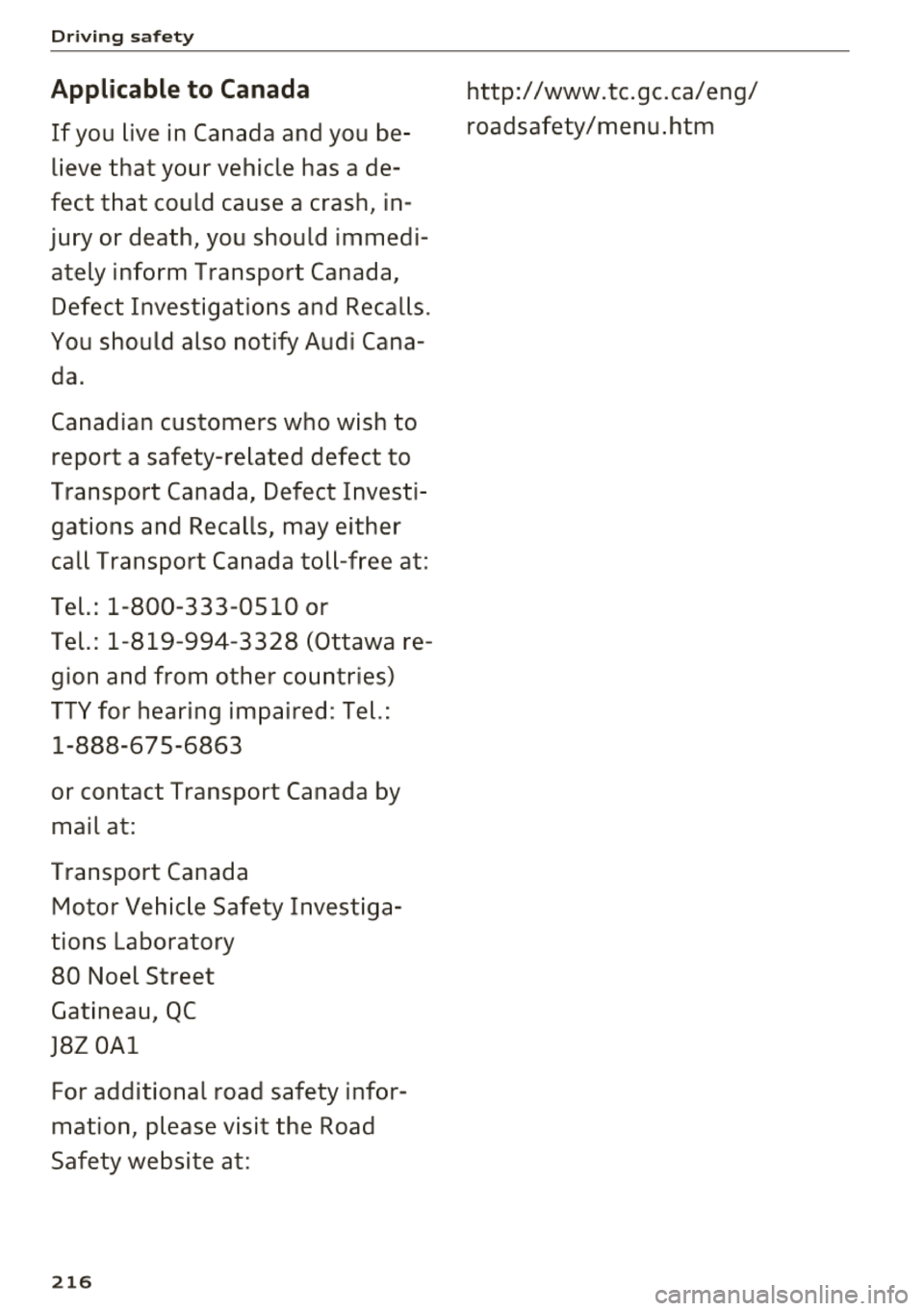
Driving safety
Applicable to Canada
If you live in Canada and you be
lieve that your vehicle has a de
fect that could cause a crash, in
jury or death, you should immedi
ately inform Transport Canada,
Defect Investigations and Recalls .
You should also notify Audi Cana
da.
Canadian customers who wish to report a safety-related defect to
T ransport Canada, Defect Investi
gations and Recalls, may either
call Transport Canada toll -free at:
Tel.: 1-800-333-0510 or T el.: 1 -819 -994-3328 (Ottawa re
gion and from other countries)
TTY for hearing impaired : Tel.:
1-888-67 5-6863
or contact Transport Canada by mail at:
Transport Canada Motor Vehic le Safety Investiga
tions Laboratory
80 Noel Street
Gatineau, QC
J8Z 0Al
For additional road safety infor
mation, please visit the Road
Safety website at:
2 16
http:/ /www.tc.gc.ca/eng/
roadsafety/menu .htm
Page 219 of 356
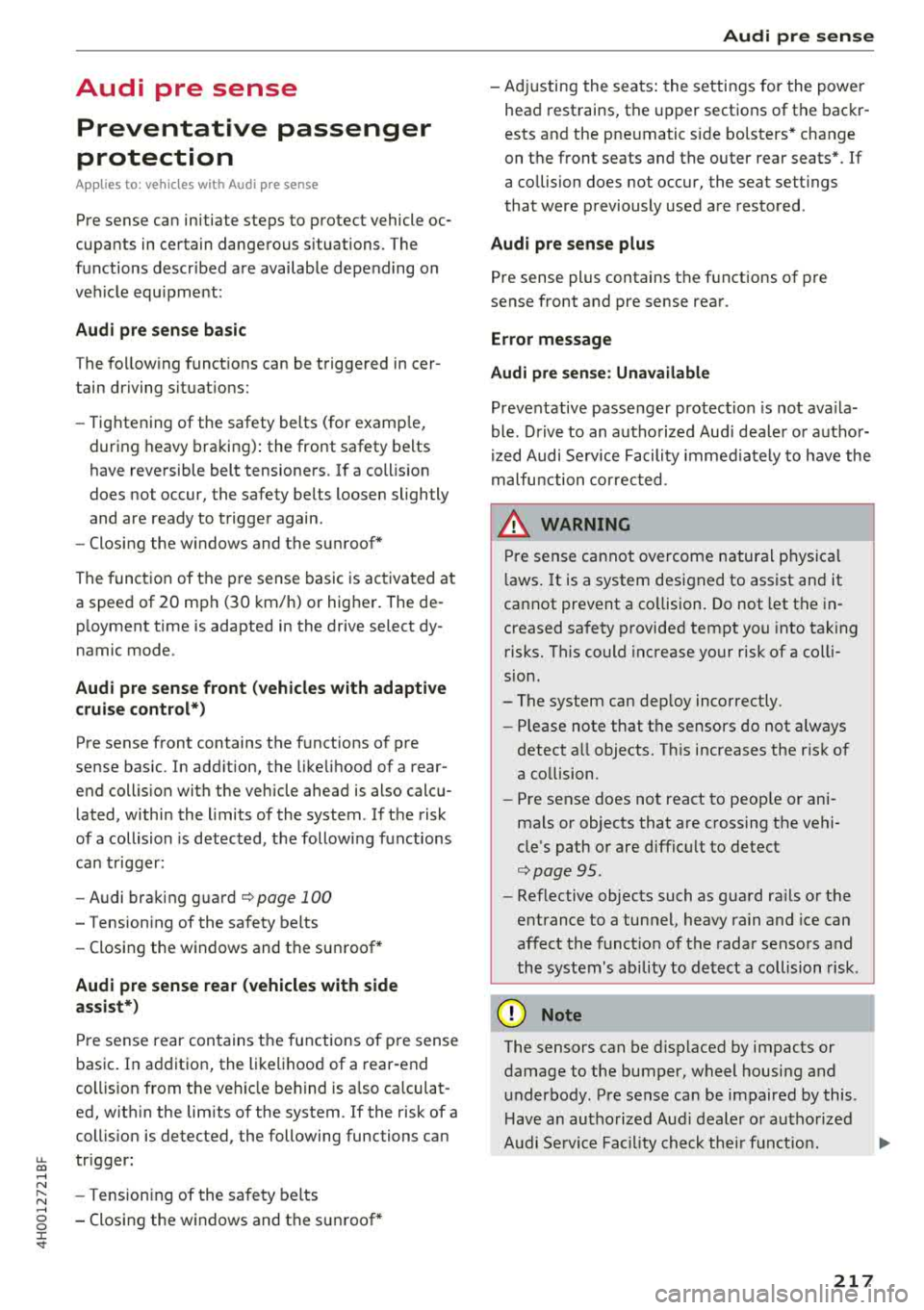
Audi pre sense Preventative passenger
protection
Applies to: ve hicles with Audi pre sense
Pre sense can initiate steps to protect vehicle oc
cupants in certain dangerous situations. The
functions descr ibed are available depending on
veh icle equ ipment:
Audi pre sense ba sic
The fo llowing functions can be triggered in cer
tain driving situat ions:
- Tightening of the safety belts (for examp le,
during heavy braking) : the front safety belts
have reversible belt tensioners. If a collision
does not occur, the safety belts loosen slightly
and are ready to trigger again.
- Closing the w indows and the sunroof*
The function of the pre sense basic is activated at
a speed of 20 mph (30 km/h) or hig her . The de
p loyment time is adapted in the drive select dy
namic mode .
Audi pre se ns e front ( vehicl es with adapti ve
cruise contr ol* }
Pre sense front contains the f unctions of pre
sense basic. In add ition, the likelihood of a rear
end collis ion with the vehicle ahead is also calcu
lated, within the limits of the system . If the risk
of a collision is detected, t he following functions
can t rigger:
- Audi braking guard
¢page 100
-Tensioning of the safety belts
- Closing the windows and the sunroof *
Audi pre sense rear (vehicles with side
a ss is t*)
Pre sense rear contains t he functions of pre sense
basic. In addition, the like lihood of a rear-end
col lision from t he vehicle behind is a lso ca lculat
ed, w ith in the lim its of the system. If the risk of a
collis ion is detected, the following functions can
~ tr igger :
.... N
~ -Tensioning of the safety belts
g -Closing the windows and the sunroof *
:c '
-Adjusting the seats : the settings for the powe r
head restrains, the upper sections of the backr
ests and the pne umatic side bolsters* change
on the front seats and the outer rear seats*. If
a co llision does not occur, the seat sett ings
that were previously used are restored .
Audi pre sen se plus
Pre sense plus contains the f unctions of pre
sense front and pre sense rear .
Error messag e
Audi pre sens e: Unavailable
Preventative passenger protect ion is not ava ila
ble. Drive to an autho rized Aud i deale r or author
ized Audi Se rvice Facility immed iately to have the
malfunction corrected.
& WARNING
--
Pr e sense cannot overcome natural p hys ica l
l aws .
It is a system designed to assist and it
cannot prevent a co llision. Do not let the in
creased safety provided tempt you into tak ing
risks. This could inc rease your r isk of a colli
sion.
- The system can dep loy incorrectly.
- Please note that t he sensors do not a lways
detect a ll objects. T his increases the r isk of
a co llision.
- Pre sense does not react to peop le or ani
mals or objects that are cross ing the vehi
cle's path or are difficu lt to detect
¢page 95.
- Reflective objects such as gua rd ra ils or the
entrance to a tunnel, heavy ra in and ice can
affect the funct io n of the radar sensors and
the system's ab ility to detect a collision risk.
@ Note
The sensors can be d isplaced by impacts or
damage to the bumper, wheel housi ng and
underbody. Pre sense can be impaired by this .
Have an autho rized Aud i deale r or au tho rized
A udi Se rvice Fac ility check the ir funct io n.
.,.
217
Page 220 of 356
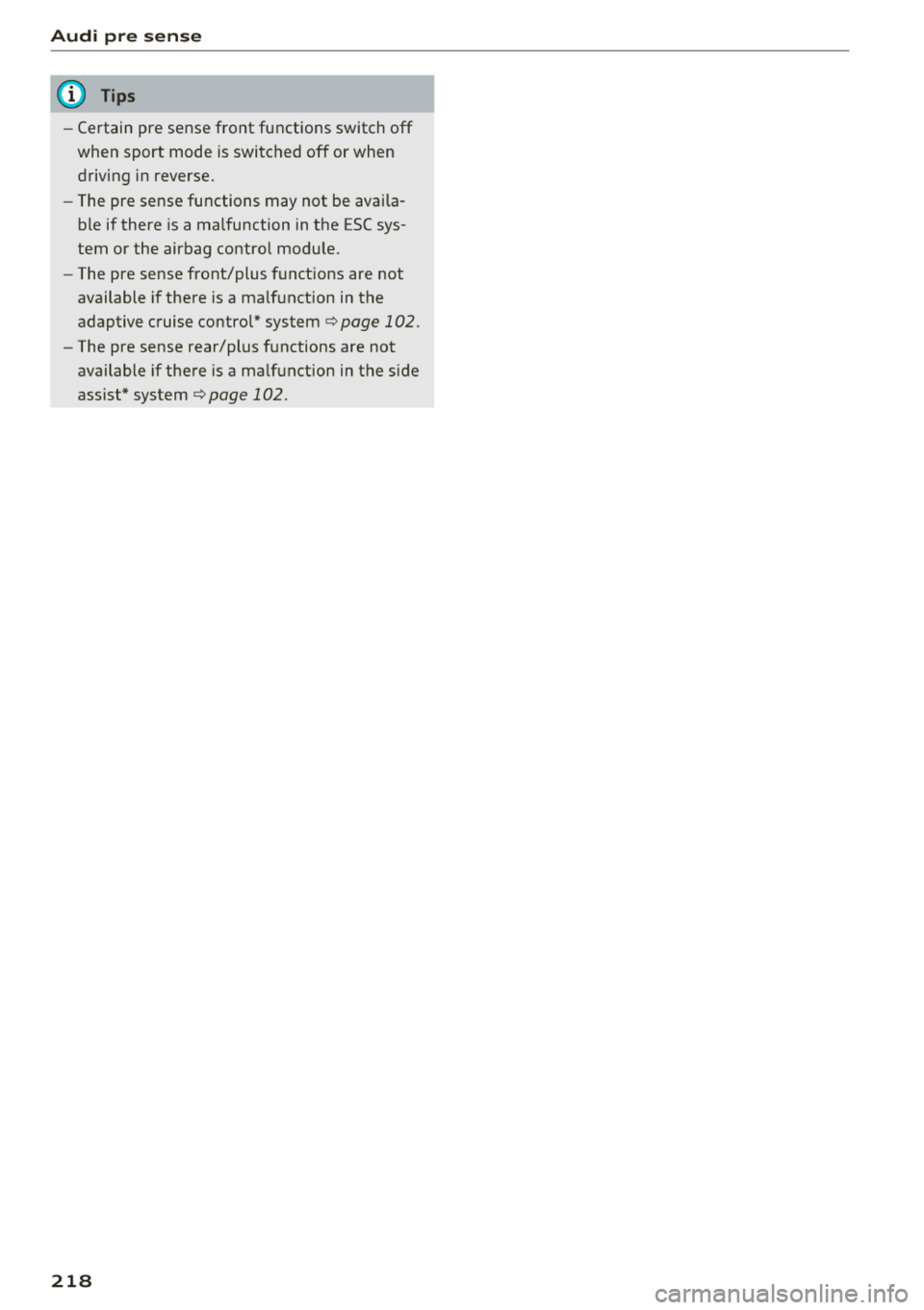
Audi pre sense
(D Tips
-Certain pre sense front functions switch off
when sport mode is swi tc h ed off or when
driving in reverse .
- The pre sense functions may not be availa
b le if there is a malfuncti on in the ESC sys
tem or the airbag contro l module.
- The pre sense front/plus funct ions are not
available if the re is a ma lf u nction in t he
adaptive c ruise contro l" system
c::;, page 102.
-The pre sense rear/plus f unctions are no t
available if the re is a ma lf u nction in the s ide
assist " system
c::;, pag e 102.
218